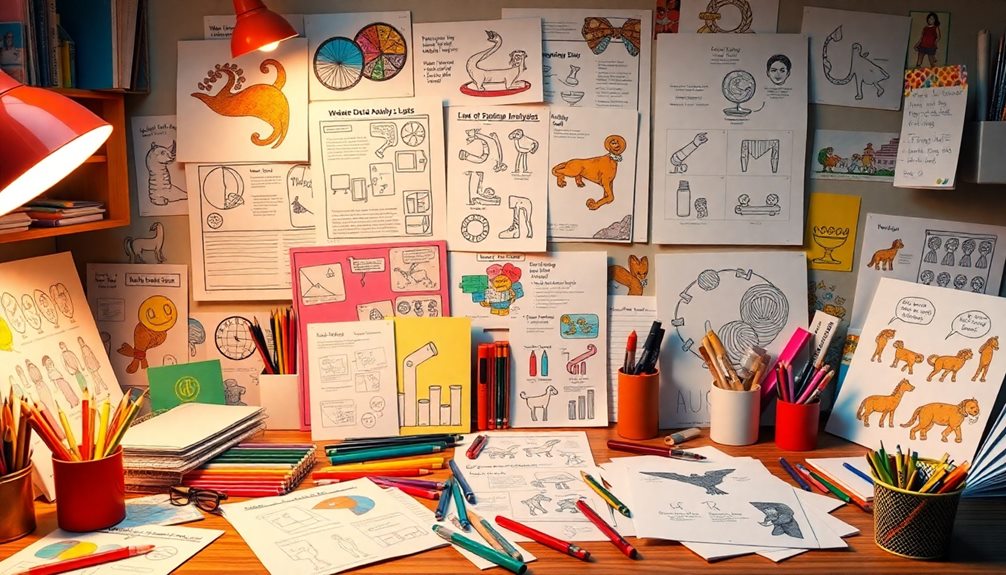To get a job in interior design without experience, focus on showcasing your transferable skills and creating a strong portfolio. Tailor your resume and cover letter to highlight relevant coursework or volunteer work. Seek internships or offer your design services to friends and family to gain practical experience. Join local design networks and attend events to connect with professionals in the field. Master tools like AutoCAD to boost your skill set. By actively engaging with the community and continuously updating your portfolio, you'll position yourself for opportunities. Keep exploring these strategies for a successful entry into the interior design world.
Additionally, don’t underestimate the power of networking and building relationships with industry professionals. Stay up-to-date with the latest interior design trends and technologies to showcase your knowledge and passion for the field. Implementing these interior design tips will help you stand out as a promising candidate and land your dream job in the industry.
Key Takeaways
- Tailor your resume and cover letter to highlight transferable skills and relevant experiences, showcasing your passion for interior design.
- Build a diverse portfolio with high-quality images, including before-and-after photos to demonstrate your design capabilities.
- Gain practical experience through internships, volunteer work, or offering services to friends and family to develop your skills.
- Network at local design events and engage on platforms like LinkedIn to connect with industry professionals and discover job opportunities.
- Prepare for interviews by showcasing professionalism, strong communication skills, and thoughtful questions about the company's work and design philosophy.
Resume and Cover Letter Tips
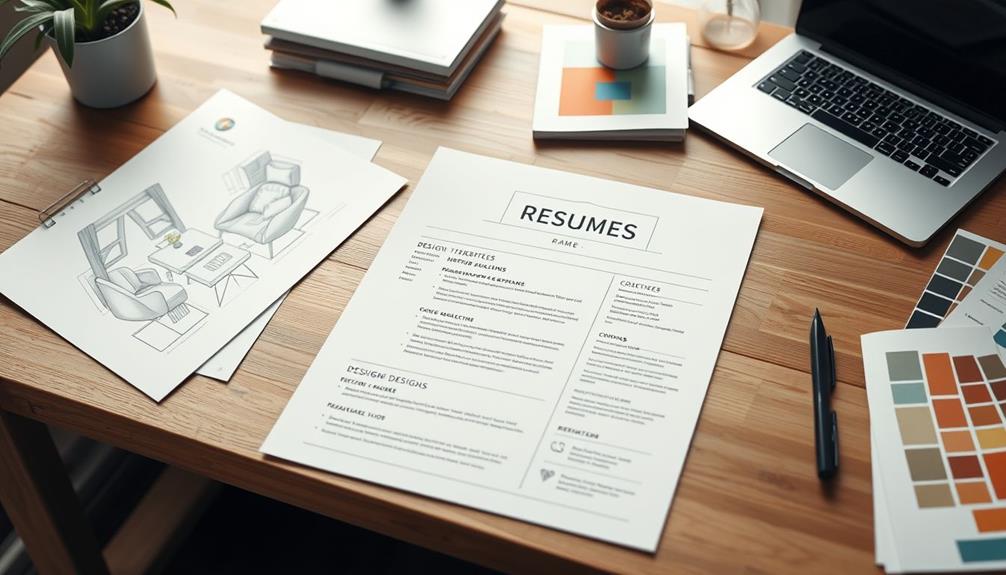
When applying for a job in interior design, your resume and cover letter are your first chances to make a strong impression. Start by tailoring your resume to highlight your transferable skills, such as project management, creativity, and customer service. Even if these skills come from unrelated fields, they can be valuable in interior design.
Include relevant coursework, internships, or volunteer experiences that demonstrate your commitment to the industry. This not only shows your knowledge but also your passion for interior design.
In your cover letter, write compellingly about why you love this field and how your unique background can bring a fresh perspective to potential employers. Use action verbs and quantify your achievements to showcase your impact in previous roles. This makes your application stand out and creates a vivid picture of your capabilities.
Finally, follow application instructions meticulously. Attention to detail in your resume and cover letter reflects your professionalism and commitment to the role.
Mastering Interview Etiquette

You've crafted a strong resume and cover letter, and now it's time to shine in the interview. First, arrive on time; punctuality is essential. It shows professionalism and respects the interviewer's time, setting a positive tone.
Next, dress appropriately. While creativity is key in interior design jobs, your outfit should align with the company culture and client expectations.
During the interview, demonstrate strong communication skills by actively listening. This helps you understand questions better and engage meaningfully with the interviewer.
It's also wise to prepare thoughtful questions about the company and its projects. This not only showcases your genuine interest but sets you apart as a candidate invested in the role.
Lastly, maintain a professional demeanor throughout the interview. Avoid distractions, like chewing gum, which can detract from your focus and professionalism.
Engaging in Meaningful Conversations

When you engage in meaningful conversations at networking events, you're not just chatting; you're building rapport with industry professionals.
Use thoughtful questions and practice active listening to show your genuine interest and enthusiasm for interior design.
This approach not only makes you memorable but also opens doors to potential job opportunities.
Building Rapport Effectively
Building rapport effectively is essential for engaging in meaningful conversations, especially in the field of interior design where collaboration and understanding are key.
To establish a strong connection with others, demonstrate active listening by giving the speaker your full attention. This shows you value their insights. Incorporate open-ended questions to encourage deeper dialogue; for instance, ask about their favorite design projects or inspirations, such as breathtaking destinations that inspire their work. This not only sparks conversation but also reveals their thought processes and preferences.
Sharing your own relevant experiences related to your professional portfolio can help create common ground. Relating your journey or showcasing your design philosophy fosters trust and connection.
Active Listening Techniques
Active listening techniques are essential tools for anyone in the interior design field, as they foster engaging and productive conversations. By focusing on active listening, you can enhance your communication skills, guaranteeing that you fully understand client preferences and concerns.
Here are some effective active listening techniques:
| Technique | Description |
|---|---|
| Paraphrasing | Restate what the speaker said to show understanding. |
| Clarifying Questions | Ask questions to clear up any uncertainties. |
| Non-verbal Cues | Use eye contact and nodding to show attentiveness. |
| Summarizing | Recap key points at the end to demonstrate absorption. |
Practicing these techniques can greatly improve your interactions during interviews and client meetings. By demonstrating engagement through paraphrasing and asking clarifying questions, you guarantee accurate understanding of their needs. Additionally, maintaining eye contact and using non-verbal cues reinforces your attentiveness, encouraging open dialogue. Summarizing key points not only reflects your understanding but also fosters a positive rapport with clients. Ultimately, mastering active listening will help you identify client preferences and pain points, making you a more effective designer in the competitive interior design field.
Thoughtful Questioning Strategies
Effective communication goes beyond just listening; it also involves asking the right questions. When interviewing with an interior design firm, prepare insightful questions that reflect your genuine interest in their design philosophy, recent projects, and future goals. This not only shows your enthusiasm but also helps you understand if the firm aligns with your aspirations.
Inquire about the specific design skills and qualities they value most in entry-level candidates. Tailor your responses to align with their expectations, making you a stronger contender for the new position.
Additionally, ask about opportunities for mentorship or training, demonstrating your willingness to learn and grow within the field.
Discuss current industry trends, including sustainability practices and new technologies, to showcase your knowledge and awareness of pressing issues in interior design. This can set you apart as someone who's engaged and forward-thinking.
Lastly, don't hesitate to request feedback on your portfolio or approach during the interview. This not only provides valuable insights but also illustrates your willingness to improve and adapt, traits that any interior design firm will appreciate in a prospective employee.
Translating Your Skills
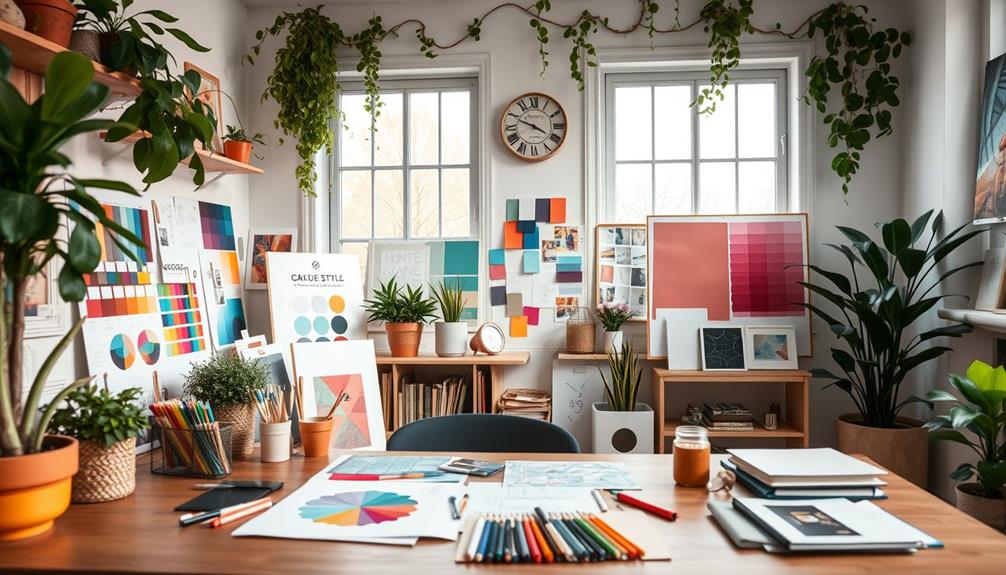
To stand out in interior design, you need to highlight your transferable skills from previous roles, like project management and customer service.
Don't forget to showcase relevant projects, whether they're personal redesigns or professional experiences, to demonstrate your creativity.
Highlight Transferable Skills
When pursuing a career in interior design, highlighting your transferable skills can be a game-changer. Identify and emphasize skills from your previous work experience, such as project management, customer service, and effective communication. These abilities are highly valued in the interior design field and can set you apart from other candidates.
Additionally, showcasing your organizational skills is essential, as they reflect your ability to manage multiple design aspects simultaneously. For instance, just as dog owners must manage their pets' health and grooming needs, effective organization in design projects leads to successful outcomes treating your dog well.
Next, focus on your creative problem-solving and organizational tasks. These skills demonstrate your capability to manage design projects and meet client needs effectively. If you have experience with design software like Photoshop, AutoCAD, or SketchUp, be sure to mention that too. You can acquire these skills through online courses or self-study, and they'll bolster your candidacy.
Additionally, use personal projects or volunteer experiences to illustrate your design skills. Discuss how you applied creativity and planning to achieve specific results, showing potential employers your practical experience.
Prepare to articulate how your past experiences can directly benefit them by addressing specific design challenges they face. By effectively highlighting your transferable skills, you'll present yourself as a strong candidate ready to take on the exciting challenges of the interior design industry.
Showcase Relevant Projects
As you begin showcasing relevant projects, remember that your portfolio is a powerful tool to demonstrate your design abilities. Start by including before-and-after photos of personal design projects or spaces you've redesigned. This visual evidence is essential for potential employers to see your style and skills in action.
Highlight any relevant coursework or certifications, like interior design principles, color theory, or CAD software. It's a great way to showcase your specific skills and commitment to the field.
Engaging in volunteer opportunities or internships can help you gain experience, so document these projects in your portfolio. This hands-on involvement is invaluable.
Don't forget to emphasize transferable skills from previous roles, such as project management and problem-solving. Provide concrete examples of how these skills apply to interior design tasks.
Lastly, take on personal design challenges, whether it's redesigning a room in your home or assisting friends and family. Including these projects in your portfolio not only exhibits your initiative but also your creativity.
Networking and Follow-Up Strategies

Networking is essential in the interior design industry, opening doors to mentorship and job referrals. By building relationships with industry professionals, you can gain invaluable insights and connections that can propel your career.
Here are some effective strategies to enhance your networking efforts:
- Attend local design events, workshops, and join organizations like ASID or IIDA to meet others in the field.
- Actively engage on platforms like LinkedIn, showcasing your portfolio and connecting with design professionals.
- Follow up with personalized thank-you emails after meetings or interviews to reinforce relationships.
When you participate in community events or volunteer for design-related projects, you not only expand your network but also demonstrate your skills to potential employers.
Keep your portfolio updated and have business cards handy, making it easier for your contacts to refer you to job openings.
Educational Pathways to Consider
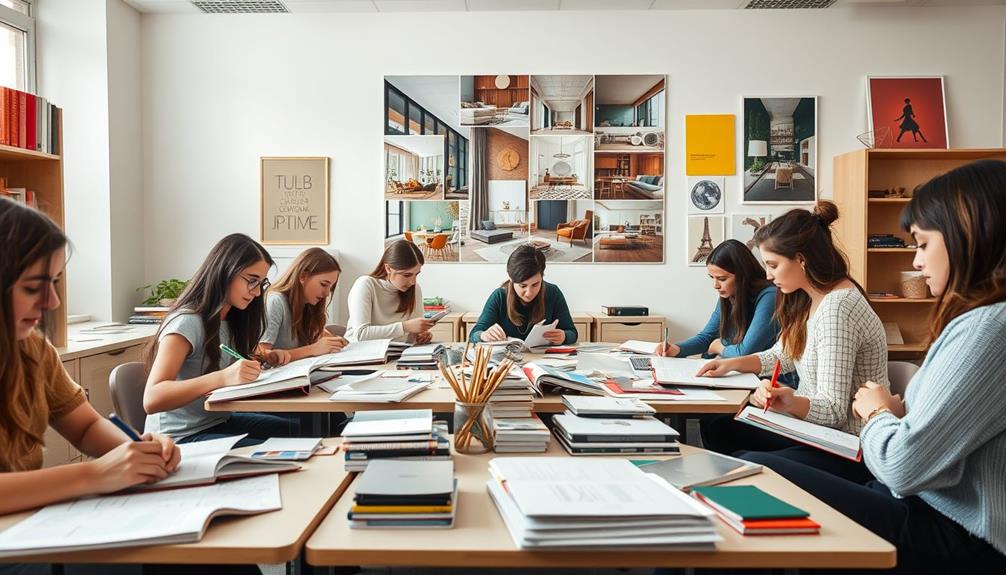
What educational pathways can you explore to break into the interior design field? Pursuing a degree in interior design, whether an Associate's or Bachelor's, can provide you with a solid foundation in design principles and industry standards. This formal education can make you more competitive for entry-level positions.
If you're looking for a quicker entry into the field, consider certificate programs in interior decorating. These programs allow you to gain specialized knowledge without the time commitment of a full degree. Verify that any program you choose is accredited by recognized bodies, like the Council for Interior Design Accreditation (CIDA), as this can greatly enhance your job prospects.
Many interior design programs also offer hands-on projects and internships, which can help you build a portfolio even if you lack prior experience.
Additionally, ongoing education through workshops, online courses, and industry seminars is essential. Staying updated on interior design trends and tools not only improves your skills but also makes you more appealing to potential employers.
Gaining Practical Experience
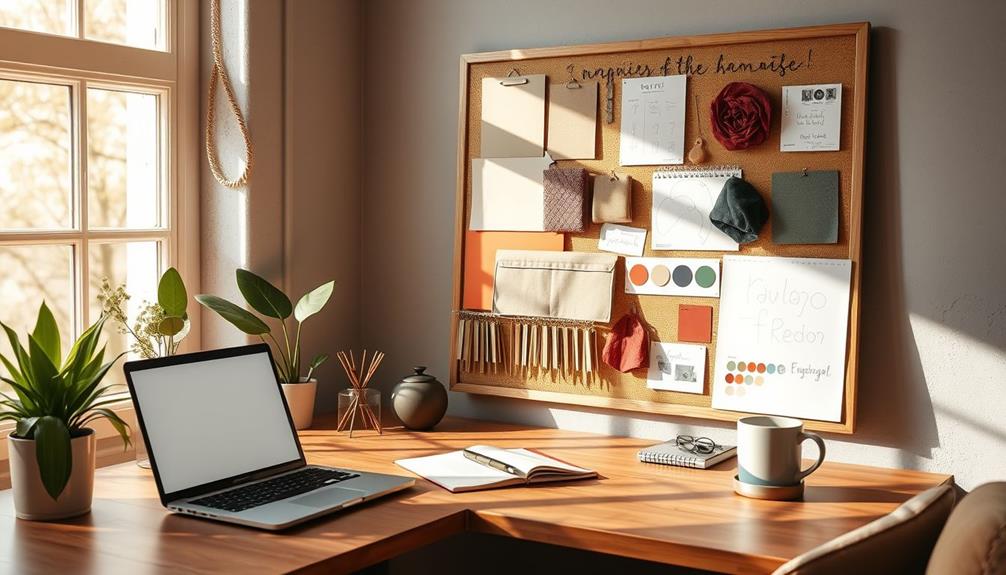
Gaining practical experience is essential for anyone looking to break into the interior design field. You need to actively seek opportunities that allow you to apply what you've learned. Start by looking for internships with established design firms, as they often provide hands-on experience and a chance to learn from seasoned professionals.
Consider these options to enhance your practical experience:
- Volunteer for community projects or non-profit organizations to gain exposure while making a difference.
- Offer your design services to friends, family, or local businesses, which helps you build your portfolio and understand client needs.
- Attend workshops and training sessions to master design software like AutoCAD or SketchUp, boosting your technical skills.
Additionally, participating in local design events or networking meetups can connect you with industry professionals who may provide valuable insights and job leads.
By focusing on gaining practical experience, you'll position yourself as a more attractive candidate to potential employers in the competitive interior design field.
Building an Impressive Portfolio
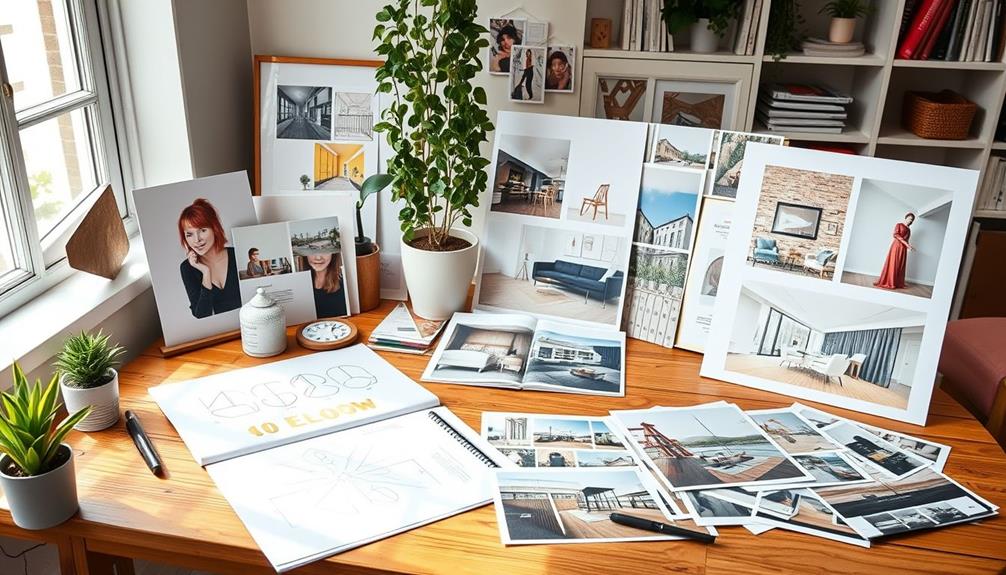
An impressive portfolio is your ticket to standing out in the competitive interior design landscape. When building a strong portfolio, include a diverse range of interior design projects. Showcase personal designs, volunteer work, and mock designs to highlight your creativity and versatility across different styles.
To effectively demonstrate your design skills, incorporate before-and-after photos. These visuals not only show your talent but also your ability to transform spaces, which potential employers will appreciate.
Remember, high-quality images and a clean layout are essential for presenting your work professionally. They notably impact how others perceive your abilities.
Consider using digital platforms like Behance or creating a personal website to make your portfolio easily accessible. This way, you can share your work with potential employers or clients at any time.
Lastly, don't forget to regularly update your portfolio with new projects and skills. Keeping it fresh and relevant is vital to reflect your growth as a designer and adapt to industry trends.
A well-curated portfolio can make all the difference in landing that interior design job you've been dreaming of.
Job Search Techniques and Resources
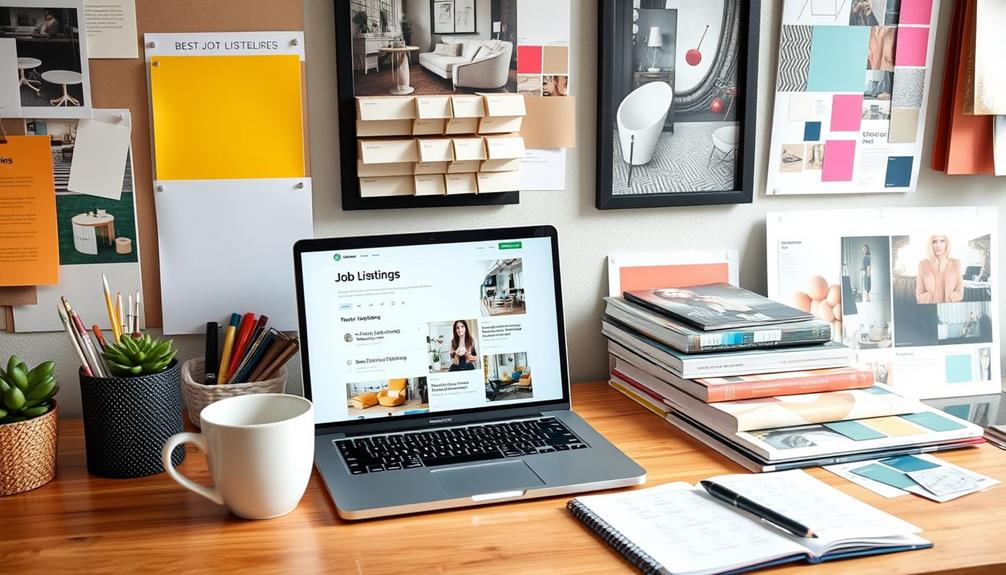
Finding a job in interior design can feel overwhelming, but with the right techniques and resources, you can navigate the process more effectively. Start by utilizing job boards like Indeed, Glassdoor, and LinkedIn, filtering specifically for internships or entry-level positions. This increases your opportunities, even if you lack experience.
Here are some effective strategies to enhance your job search:
- Network within local design communities: Attend industry events and connect with professionals on LinkedIn to gain insights and potential job leads.
- Volunteer for non-profits or community projects: This not only builds your practical experience but also enhances your resume and portfolio.
- Create a strong online portfolio: Showcase your personal design projects and skills to attract the attention of potential employers.
Additionally, engage in informational interviews with industry professionals. They can provide invaluable advice on entering the field and might reveal hidden job opportunities that aren't publicly advertised.
Conclusion
Stepping into the world of interior design without experience might feel like diving into uncharted waters, but with determination and creativity, you can navigate your way to success. Remember, every designer started somewhere, and your unique perspective is your greatest asset. Embrace opportunities to learn and connect, and soon, your passion will illuminate the path to your dream job. So take a deep breath, trust your instincts, and let your vision transform spaces—and your career.





